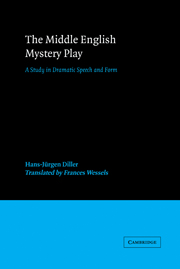Book contents
- Frontmatter
- Contents
- Preface
- Note on texts used
- Abbreviations and special symbols
- Introduction
- Part I The foil: Latin church drama
- 1 Liturgy and drama
- 2 Liturgical point of view surrounding the dramatic core dialogue
- 3 ‘World-containing’ situations
- 4 The dramatization of narrative sources
- Part II The English Creation to Doom cycle
- Notes
- Bibliography
- Indexes
2 - Liturgical point of view surrounding the dramatic core dialogue
Published online by Cambridge University Press: 04 March 2010
- Frontmatter
- Contents
- Preface
- Note on texts used
- Abbreviations and special symbols
- Introduction
- Part I The foil: Latin church drama
- 1 Liturgy and drama
- 2 Liturgical point of view surrounding the dramatic core dialogue
- 3 ‘World-containing’ situations
- 4 The dramatization of narrative sources
- Part II The English Creation to Doom cycle
- Notes
- Bibliography
- Indexes
Summary
Lyrico-liturgical point of view after the core dialogue
The situation-bound and hence, in our sense, ‘dramatic’ Quern quaeritis dialogue never appears alone. Even in the oldest texts of the Visitatio Sepulcri it is surrounded by ‘non-dramatic’ text. As a rule, it is at least accompanied by the antiphon Surrexit or Resurrexit Dominus, whereby the Women pass the message of the Resurrection on to the choir. Young considers this a regrettable accident of textual transmission. Apparently he assumes that the seed of the liturgical drama must have existed once in pure form, without any traces of the surrounding liturgical context. But this is exactly what is open to question. While David A. Bjork has produced impressive evidence that the Quern quaeritis trope ‘is a selfcontained little song’, it still seems to be the case that important dramatic features do not accrue to the original dialogue unless they are accompanied by certain non-dramatic ones. The ‘dramatic features’ in question all serve to make the Second World situation visible (as opposed to audible, which was of course done already by the unamplified Quern quaeritis dialogue). The ‘non-dramatic’ features lead us out of the Second World and back into the First World of the liturgical ceremony.
Since the compilers of these offices were primarily interested in heightening the effect of the liturgical Revelation and not in a scenic version of the biblical narrative, it is quite possible - and even probable, in view of the testimony of the texts - that the passing on of the message was an integral part of the scene from the very beginning.
- Type
- Chapter
- Information
- The Middle English Mystery PlayA Study in Dramatic Speech and Form, pp. 25 - 32Publisher: Cambridge University PressPrint publication year: 1992



